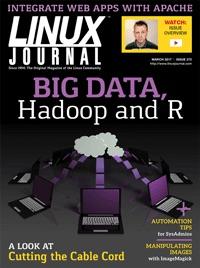Linux Journal March 2017


It's a Bird! It's a Plane! Nope, It's My Server!
Like most fancy tech terms, "Cloud Computing" has lost its newness, and it's now just a commodity we purchase. It's often so much easier to provision virtual machines than it is to buy and host your own servers. Yes, there are concerns over privacy and security when your data is in the cloud. When you host in your own data center, however, there's still the possibility of a rogue cleaning crew getting to your servers. (We've all seen the movies; it just takes a mop and a blue jumper to get you into the most secure data center.) Regardless of your stance on cloud computing, it's here to stay. This month, we talk a bit about how to live in this bold new world.
Reuven M. Lerner starts things off with more information about machine learning. What if the software itself could suss out the important patterns and information from your data instead of feeding it presorted information for simple data mining? Reuven describes "unsupervised machine learning" this month, and it's either awesome or terrifying, depending on how you feel about such things.
Dave Taylor follows with a look at one of my favorite command-line application suites: ImageMagick. I use a few of the tools with my ongoing birdcam project. Dave explores all sorts of ways to manipulate images from the command line, and his article is only the tip of the iceberg!
Kyle Rankin delves into automation for sysadmins this month. Thanks to DevOps and the like, task automation is far more robust than it used to be. Kyle explains why we should automate, when we should automate and how we should go about doing it. Although it's tempting to replace your system administrator with a few DevOps tools, that human factor is invaluable.
I take a look at entertainment this month, specifically as it pertains to watching television. Many of you are "cord cutters", but for the few still holding on to their cable subscription (such as myself), it's important to understand the various options out there. Thankfully, we're closer to a complete television experience over the internet than ever before. This month, I look at some of the available options.
Rune Torbensen and Søren Top describe building a Linux cluster in the cloud for the purpose of data analysis with R. Building a huge cluster of machines in your own data center is impractical for most people, especially when that cluster isn't needed as a permanent fixture. Rune and Søren show how to take advantage of the cloud along with open-source tools like Hadoop and R to analyze logs.
Andy Carlson follows them with an article on writing custom Apache configurations in order to run specific applications on the web. Yes, it's the sort of thing you can do on your own hardware, but again, the cloud is a convenient way to treat computing like a commodity, so having methods that are flexible are vital in our modern IT world.
Love it or hate it, the cloud isn't going away any time soon. As someone who historically has had server racks full of last-generation servers in his basement (that's all I could afford), I can't express how happy the cloud makes me. Before you can safely take advantage of using someone else's servers for your data, it's important to understand not only how the cloud itself works, but also how your software integrates. And understanding open-source software is what we love most here at Linux Journal!
Available to Subscribers: March 1










